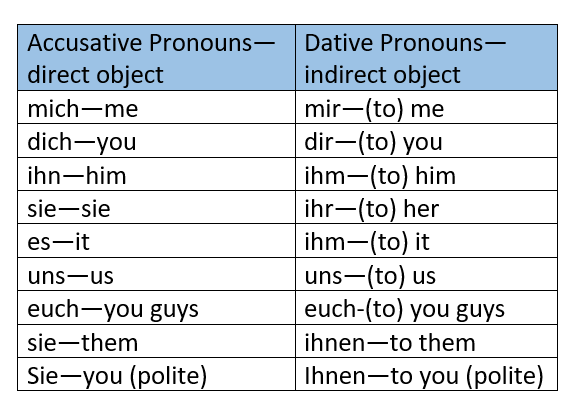9 Section 4-9: Word Order
4.9 Word Order
Earlier, you learned that in German, the word order for indirect and direct objects tends to be as follows.
Subject/Verb/Indirect/Direct
S V I D
Du gibst dem Mann das Geld.
(You give the man the money.)
But what happens if you start putting in pronouns for the direct and indirect objects? For starters, let’s look at a review of both the accusative and dative personal pronouns. You learned the accusative pronouns in Chapter 2 and the dative ones in this chapter.

In the following example, we will replace the direct object (accusative case) and the indirect object (dative case) with pronouns. Notice how the word order turns out.
Sentence: Der Tourist schickt seiner Mutter eine Postkarte.
Replace the indirect object with a pronoun:
- Step 1: Identify the indirect object→seiner Mutter
- Step 2: “Mutter” is feminine. The dative case (aka indirect object) pronoun for feminine is ihr.
- Step 3: Der Tourist schickt ihr eine Postkarte.
S V I D
- The word order is still SVID.
Replace the direct object with a pronoun:
- Step 1: Identify the direct object→eine Postkarte
- Step 2: “Postkarte” is feminine. The accusative case (aka direct object) pronoun for feminine is sie.
- Step 3: Der Tourist schickt sie seiner Mutter.
S V D I
- The word order has changed to SVDI.

FRAGE: Why does the word order change to SVDI sometimes?
ANTWORT: Have you noticed that the pronouns we’ve been substituting in tend to be very short? German tends to want to protect the small words by keeping them on the inside of the sentence instead of moving them to the outside of the sentence.
GOAL: Protect small pronouns by sandwiching them in between the bigger words in the sentences.

The good news is that you will “protect” the small pronoun no matter whether or not you substitute a direct or an indirect object. It must always be sandwiched into the middle of the sentence.
WHAT IF YOU REPLACE BOTH PRONOUNS?
Der Tourist schickt seiner Mutter eine Postkarte.
- Step 1: Identify both the direct and indirect objects: Mutter and Postkarte.
- Step 2: Mutter is the indirect object→ihr; Postkarte is the direct object→sie.
- Step 3: Der Tourist schickt sie ihr. (SVDI)
Rule: When replacing BOTH, use SVDI.

Why? Because you’re replacing so many words that it makes you want to DI. (Get it? Die? Di?) In any case, use this extremely cheesy joke to help you remember word order.
If it helps, you can compare this to English. Although you may never have noticed, we do the exact same thing in English.
Example sentence:
- German: Sie gibt ihrem Vater einen Roman. (SVID)
- English: She gives her father a novel. (SVID)
Substitute in for indirect object:
- German: Sie gibt ihm einen Roman. (SVID)
- English: She gives him a novel. (SVID)
Substitute in for direct object:
- German: Sie gibt ihn ihrem Vater. (SVDI)
- English: Sie gives it to her father. (SVDI)
Substitute in for both direct and indirect objects:
- German: Sie gibt ihn ihm. (SVDI)
- English: Sie give it to him. (SVDI)

Realistic Learning Tip: Strive for excellence in word order, but don’t throw in the towel if you make a mistake. More likely than not, native speakers will understand what you’re trying to say anyway. That being said, practice will only make you reach the goal of excellence sooner.
Click to see me reteaching word order with both accusative and dative pronouns:
Click to watch YourGermanTeacher’s video that reviews all cases—Nomiativ, Akkusativ, and Dativ, along with word order:
Ex. A: SVID und SVDI. Using the sentences below, practice substituting in pronouns for direct and indirect objects. Rewrite the entire sentence.
- Die Bäckerin empfiehlt der Kundin eine Brezel.
- Replace the indirect object with a pronoun. (SVID)
- Replace the direct object with a pronoun. (SVDI)
- Replace both the direct and indirect objects with pronouns. (SVDI)
- Der Sekretär gibt seinem Chef ein Wörterbuch.
- Replace the indirect object with a pronoun.
- Replace the direct object with a pronoun.
- Replace both the direct and indirect objects with pronouns.
- Der Tourist schickt seiner Mutter einen Brief.
- Replace the indirect object with a pronoun.
- Replace the direct object with a pronoun.
- Replace both the direct and indirect objects with pronouns.
- Die Studenten zeigen ihrem Freund ein Foto.
- Replace the indirect object with a pronoun.
- Replace the direct object with a pronoun.
- Replace both the direct and indirect objects with pronouns.
- Das Kind schenkt seinem Hund einen Knochen.
- Replace the indirect object with a pronoun.
- Replace the direct object with a pronoun.
- Replace both the direct and indirect objects with pronouns.
- Die Buchhandlung gibt den Kunden einen Roman.
- Replace the indirect object with a pronoun.
- Replace the direct object with a pronoun.
- Replace both the direct and indirect objects with pronouns.
- Der Fußballspieler wirft (throws) dem Basketballspieler einen Golfball.
- Replace the indirect object with a pronoun.
- Replace the direct object with a pronoun.
- Replace both the direct and indirect objects with pronouns.
- Der Zombie kauft der Hexe einen Geist.
- Replace the indirect object with a pronoun.
- Replace the direct object with a pronoun.
- Replace both the direct and indirect objects with pronouns.
EXTRA PRACTICE: Go to Germanzone.org’s website to practice the difference between accusative and dative pronouns.
https://www.germanzone.org/the-personal-pronouns-direct-object-or-indirect-object/
Or try Claudia Kost’s and Crystal Sawatzky’s (University of Alberta) exercise:
Watch Easy German’s video to see some common everyday interjections in German.
DEUTSCHE MUSIK: Do you like learning new German words through song lyrics? This YouTube account has lots of German songs that break down the lyrics for you to help you learn more German.
https://www.youtube.com/channel/UCnMNqL_8WqVCtefcMHrA1sQ/videos

